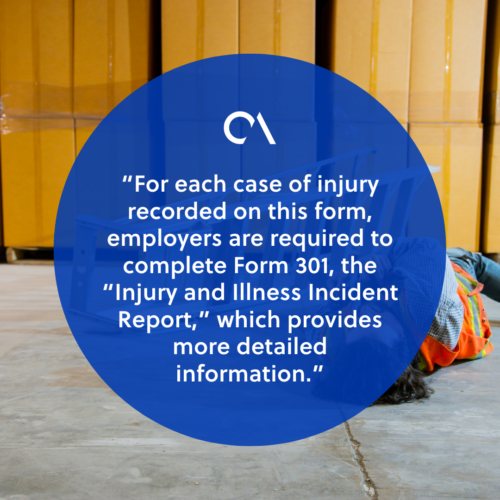An overview of OSHA Form 300

OSHA Form 300 is an essential document in the realm of workplace safety, tracking and recording work-related injuries and illnesses.
The Occupational Safety and Health Administration (OSHA) is an agency dedicated to fostering safe and healthy working conditions. Form 300 stands as an important tool for employers to track incidents, identify trends, and implement preventive measures.
This article examines OSHA Form 300 and its pivotal role in maintaining a secure work environment.
What is OSHA Form 300?
See Form 300 (Rev. April 2004)
OSHA Form 300, officially known as the “Log of Work-Related Injuries and Illnesses,” is a crucial component of OSHA’s recordkeeping requirements.
This form is designed to promote workplace safety and transparency by tracking and recording all significant work-related injuries and illnesses that occur in the workplace. It’s a standardized method of documenting incidents that help identify hazard patterns.

By maintaining accurate and up-to-date records on OSHA Form 300, employers are better equipped to:
- Analyze trends
- Evaluate safety programs
- Ensure compliance with OSHA regulations
Types of injuries that must be recorded
In general, any injury or illness is recordable in OSHA Form 300 if it falls under one or more of the following criteria:
- Death/fatalities – Any work-related fatality must be recorded on OSHA Form 300, regardless of the time lapse between the incident and the employee’s death.
- Loss of consciousness – If an employee loses consciousness due to a work-related incident, it must be recorded on OSHA Form 300, regardless of the duration.
- Injuries and illnesses resulting in days away from work – Any injury or illness resulting in an employee being away from work beyond the day of the incident.
- Injuries and illnesses resulting in restricted work or job transfer – Injuries or illnesses that result in an employee being assigned to a restricted work activity or transfer to a different job within the organization.
- Medical treatment beyond first aid – If an injury or illness requires medical treatment beyond first aid, such as prescription medication or more advanced medical care.
- Work-related diagnosed cases – Work-related cases diagnosed by a physician or other licensed healthcare professional, such as occupational illnesses or chronic conditions.
- Needlestick and sharps injuries – Injuries from contaminated sharps, such as needlesticks, are also recordable.
These are the primary types of injuries and illnesses that must be documented on OSHA Form 300. Employers can create a safer and healthier work environment by accurately reporting these incidents.
What businesses need to fill out OSHA Form 300
Businesses in the United States that fall under the jurisdiction of the Occupational Safety and Health Administration are required to fill out OSHA Form 300.

You must complete OSHA Form 300 if you have more than ten employees and fall under one of the industries that OSHA covers. Among others, these include:
- Manufacturing
- Construction
- Healthcare
- Retail
- Transportation
- Agriculture
- Services
It’s important to note that certain low-hazard industries may be partially exempted from maintaining OSHA injury and illness records.
Exempt industries include:
- Finance
- Insurance
- Real estate
- Certain retail establishments
However, even within these industries, some businesses may be classified as high-hazard and will be subjected to specific reporting requirements. In that case, they are obligated to fulfill OSHA Form 300.
Businesses should always check the latest OSHA guidelines and regulations to determine their specific requirements.
How to complete Form 300
Here are the steps to complete OSHA Form 300:
- Understand OSHA recordkeeping requirements – Familiarize yourself with OSHA’s requirements and what constitutes a recordable injury or illness.
- Obtain OSHA Form 300 – You can download the form from the OSHA website or request a copy from your local OSHA office.
- Gather necessary information – Collect all relevant details for each incident.
- Determine the severity – Determine the severity of the incident based on its outcome.
- Complete the form – Fill out the main body of the form, which consists of columns to record information for each incident.
- Calculate the total number of hours worked – Sum up the total number of hours worked by all employees during the calendar year.
- Review and verify – Double-check all the information on the form for accuracy and completeness.
- Maintain the form – Retain the form in your records for a period of five years to make it easily accessible for OSHA inspections.
You may have an EHS specialist assist you during this process.
What details need to be included in OSHA Form 300?
The following details need to be included to complete OSHA Form 300:
- Employee information – Record the name and job title of the employee who experienced the injury or illness.
- Case description – Provide a description of the injury or illness, including how it happened and its nature.
- Date of the incident – Enter the date when the incident occurred.
- Location of the incident – Specify the workplace location where the incident occurred.
- Days away from work – If the injury or illness resulted in the employee being absent, record the number of days away from work.
- Restricted work or job transfer – Document the details if the employee was assigned to restricted work activities or transferred to a different job.
- Outcome of the incident – Record the outcome of the incident.
Note that OSHA Form 300 is only part of a broader recordkeeping process.
For each case of injury recorded on this form, employers are required to complete Form 301, the “Injury and Illness Incident Report,” which provides more detailed information.
Additionally, a summary of this data, known as Form 300A, is required to be posted in the workplace each year.

What if you do not file Form 300?
Failure to file OSHA Form 300, or to comply with OSHA’s recordkeeping requirements in general, can result in serious consequences for employers.
If an employer does not comply, they may face the following:
- Penalties – OSHA has the authority to issue penalties and citations for violations of recordkeeping requirements. Penalties and fines can vary based on the severity of the violation and the employer’s history.
- Difficulty identifying trends – Failure to maintain accurate records can impede your ability to address safety issues and areas of concern.
- Reputational damage – Inaccurate or incomplete recordkeeping can erode your credibility and reputation, both with employees and regulatory agencies. It may also create challenges in defending against claims or disputes.
- Legal consequences – Non-compliance with OSHA recordkeeping requirements may have legal implications for employers.
- Enforcement actions – OSHA may enforce with a higher degree of scrutiny, including conducting inspections and investigations to ensure compliance.
- Loss of benefits – Certain employers, especially those in industries with federal contracts, may risk losing benefits if they fail to comply with OSHA regulations.
To avoid these consequences, employers should prioritize adherence to OSHA’s requirements.
Properly completing and maintaining OSHA Form 300, along with other relevant forms, is essential to demonstrate compliance and effectively manage workplace safety.
Trust us, your workers will thank you for it as well.







 Independent
Independent




